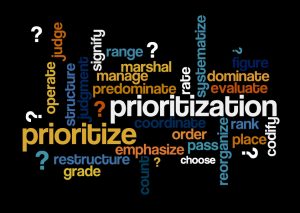What is Focussed Improvement
 Are you and your team inundated with an overload of corrective and preventive actions (CAPA’s)? Do you see a continuous history of not delivering your CAPA’s in full and on time? Do you struggle to get the right people and departments involved in addressing your CAPA actions? In other words: do you feel that your CAPA system is not working for you at all?
Are you and your team inundated with an overload of corrective and preventive actions (CAPA’s)? Do you see a continuous history of not delivering your CAPA’s in full and on time? Do you struggle to get the right people and departments involved in addressing your CAPA actions? In other words: do you feel that your CAPA system is not working for you at all?
Too often we encounter organization that have a comprehensive approach and even automated systems to manage CAPA’s, but with limited or no success. An overload in CAPA’s and too little involvement throughout the organization will result in not achieving the results you are aiming for.
This article will show you the five critical steps you must take to achieve an efficient and effective CAPA approach for your organization, that will deliver results. It is a relative simple approach but it will take perseverance to implement and in certain terms even a leap of faith to start doing it.
Stop doing everything
 First of all a lot of quality management systems are set up to define CAPA’s for everything -this will most certainly result in a CAPA overload in the organization. Does this give you a focussed improvement? As with any aspect in life and in management it is important to focus on those CAPA’s that will deliver the biggest value to the organization and of course to perform CAPA’s which are mandatory to perform as part of the company’s certification scheme’s.
First of all a lot of quality management systems are set up to define CAPA’s for everything -this will most certainly result in a CAPA overload in the organization. Does this give you a focussed improvement? As with any aspect in life and in management it is important to focus on those CAPA’s that will deliver the biggest value to the organization and of course to perform CAPA’s which are mandatory to perform as part of the company’s certification scheme’s.
For most certification scheme’s CAPA’s are only mandatory for severe issues regarding the following topics:
- CCP / oPRP breaches
- Food safety related complaints
- Food safety related blocked stock
- External audit findings (typically major and critical observations)
- Repeat issues (repeating complaints / repeated blocked stock issues)
- Critical or food safety internal audit findings
- Recalls
This means that not for every complaint, every time stock is blocked and for each internal audit or daily inspection round finding a CAPA has to be defined. If your current CAPA system is operating in a mode where too many CAPA’s have been defined, perform an one-time assessment on those which are not critical and close all or most of the non-important ones. You still might want to execute the focussed improvement action though! Of course this is much lighter as there is no full-fledged investigation necessary anymore.
Prioritize your CAPA’s
 One of the most important things to always do is prioritize – this is true for every aspect in life and every aspect in management and most certainly for CAPA management. When assessing the prioritization of CAPA’s there are two aspects to take into consideration:
One of the most important things to always do is prioritize – this is true for every aspect in life and every aspect in management and most certainly for CAPA management. When assessing the prioritization of CAPA’s there are two aspects to take into consideration:
- Compliance – CAPA’s in relation to external audits often need to be performed within a certain time frame in order not to compromise the continuation of the certification.
- Risk – CAPA’s in relation to food safety issues or large amounts of stock / value pose a higher risk to the company and therefore should be given a higher priority.
Next to setting the priority based on these two factors there is one more important concept to be discussed: the execution of the actions. If you define CAPA’s in two parts, the root cause analysis (RCA) and the execution of the corrective / preventive actions, you will see that the RCA is the time critical part in relation to compliance based CAPA’s. Very often the certification scheme and customers will allow you the time you need to realistically address the improvement actions that you need to take in relation to a CAPA, but the RCA, including the definition and communication of the improvement actions must be done within the set time frame.
This also holds true for the CAPA’s which are risk related: you want to perform the RCA as soon as possible so you can do a further prioritization on the improvement tasks that need to take place, based on the (financial) risks which will be reduced by each of the actions – starting with the improvement actions which have the biggest impact first.
There is no need to create an elaborate structure for priority management, a simple High-Medium-Low approach will work fine: just put the compliance and high risk issues at high priority for performing the RCA and implement a similar structure for the improvement actions. Read our article on RCA as well to have a powerful method for this.
Define one or two big wins
 Even though you have set priorities as described in the previous section, it is still wise to select one or two (no more!) big wins that you want to achieve within a certain period (for a start just take one year). These big wins should be linked to an area which is giving you big issues at the moment, so a good place to start is to make a breakdown of all the complaints and reasons for blocked stock and perform a Pareto Analysis on this. You should then take either the biggest item or the second or third biggest item, based on which one you feel will be easiest to solve.
Even though you have set priorities as described in the previous section, it is still wise to select one or two (no more!) big wins that you want to achieve within a certain period (for a start just take one year). These big wins should be linked to an area which is giving you big issues at the moment, so a good place to start is to make a breakdown of all the complaints and reasons for blocked stock and perform a Pareto Analysis on this. You should then take either the biggest item or the second or third biggest item, based on which one you feel will be easiest to solve.
The reason for taking this approach is that you want to change the mentality in the organization towards a truly pro-active mentality. At the same time you need to get the attention and buy-in of management to invest time, money and other resources into addressing this one or these two big issues within the organization. It will be difficult to convince management to take a lot of actions, more over actions that have a unclear amount of saving potential or too many little savings. This is why picking one or two big topics will really get you the level of attention you need, because most likely the savings will be substantial.
The final reason to pick only one or two big wins is that it allows you to shape the measure of success yourself. By taking one or two big wins as part of your overall improvement approach, you will not only create focus at management level and in the wider organization, but you will also create focus in the way you and your team will be evaluated at the end of the year. If you are able to deliver on the improvement targets that you have set as part of these one or two big items, you and your team will be seen as very successful, which will make it more easy to continue this approach in the subsequent years.
Involve the right people
Very often quality manager and their teams are seen as the ones who are responsible to deliver all the improvement actions in relation to quality and food safety in the organization. Of course this is not a good situation as for most issues departments like production, purchasing ,warehousing and operations needs to be involved to successfully address the issues at hand. This situation seems to be strengthened by the perception that improvement actions are a necessary burden on the organization for certification purposes only.
By creating a more focussed approach for improvement actions and defining one or two big wins, you will lay the foundation for success. The third crucial element is to involve the right people in each of the improvement activities. The quality department is not the process owner of areas like production, purchasing, warehouse management or operations, hence the right people of these departments need to be involved in the improvement activities, moreover they might even be required to take the lead in these activities and hence really own them.
The best place to start of course is to discuss the new way of working first with the managers of the respective departments, and better even the entire management team. It is important to convey the message that focussed improvement in the way as described in this article is the corner stone of quality driving for and delivering profit to the company. Based on the insights gained from the cost of non-quality data, you can even give a crude value of the benefits to be achieved by this approach.
Be adaptive
 As with any aspect in life and in business, one thing you can be certain of: when you have drawn your plans, things will change and more pressing issues might arise during the year. The approach as described in this article easily adapts to this as you can change priorities for the improvement actions as dictated by the business needs. However, this comes with one big caveat: do not change the one or two big improvement activities that you are working on – these are still big contributors to the issues that are present in the company and these must be addressed on a structural basis. Only by having a continuous, year on year focus on one or two big improvement areas you will be able to significantly improve the company’s quality and food safety and financial performance.
As with any aspect in life and in business, one thing you can be certain of: when you have drawn your plans, things will change and more pressing issues might arise during the year. The approach as described in this article easily adapts to this as you can change priorities for the improvement actions as dictated by the business needs. However, this comes with one big caveat: do not change the one or two big improvement activities that you are working on – these are still big contributors to the issues that are present in the company and these must be addressed on a structural basis. Only by having a continuous, year on year focus on one or two big improvement areas you will be able to significantly improve the company’s quality and food safety and financial performance.
In terms of the activities that need to take place you cannot down-prioritize the execution the RCA for critical issues, these must be executed at all times in the shortest term possible. The main area where you can and must be adaptive is the speed of execution in and prioritization of the improvement actions. Especially the medium and low priority improvement actions allow you to be adaptive. If the organization work load is still too high after shifting the medium and low priority improvement, you can focus on the re-prioritization of the high priority improvements by downgrading the least important once to a medium level.
When changing priorities in the improvement actions for the organization you must discuss this in full in the management team for two reasons:
- You want the full buy-in of the management team to ensure the management team stays connect and co-owns the improvement program. This way you can also manage expectations of a crucial set of stakeholders towards the delivery as part of your annual plan.
- By formally discussing this in the management team you can designate this part of the management team meeting as an intermediate management review in terms of your certification scheme and thus have this logged as a formal change of priorities.
Conclusion
By creating a more focussed approach toward CAPA’s and set one or two big wins in terms of focussed improvement projects in the organization you will be driving for continuous value generation and really show the true benefit of continuous improvement as part of the wider quality and food safety management approach in the organization. You need to involved all relevant managers in details and the entire management team for approval and deciding on changes in priorities when needed.
Blogs you might be interested to read as well:
7 Steps to be IMPACTFUL as a Quality Manager
6 Steps to Create a Strong Team
5 Essential Must Do’s for Creating a Compelling Multi-year Plan
